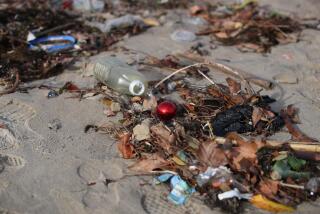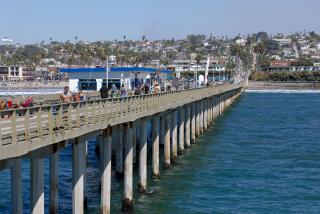Cape May, N.J., is like an old love
Poor New Jersey. Long the butt of jokes and a source of nationwide scorn, the Garden State’s reputation has taken countless beatings over the years. And thank you, “Jersey Shore,” for doing nothing to elevate the maligned state’s image. So it came as no surprise to see the reactions of fellow Angelenos when I stated our plans last August: a vacation in the seaside hamlet of Cape May, the southernmost town on the Jersey coast and America’s first seashore resort. The responses ranged from pity to bewilderment to smirking, with only a few registering as enthusiastic understanding. For as anyone who has been there knows, Cape May, with its lovely stretch of sand and swaying sea grass, historic Victorian architecture and village-like ambience, offers the quintessential American beach experience.
My trip was a homecoming of sorts. Almost every summer in my youth, my family drove from our home in Pennsylvania to a rented vacation house at “the shore” (it is indeed referred to as the Jersey shore, not the Jersey beach), to the towns of understated Stone Harbor or boardwalk-centric Ocean City. Ocean City is also where I spent college summers waitressing and testing how little sleep I needed to survive. But if those places beckoned in my youth, Cape May became the go-to spot as I grew older, and my husband, Steve, who had made an annual trek there with his sons as a respite from the hot asphalt of Philadelphia, shared my fondness for the town’s old-fashioned authenticity.
So Steve and I and our 7-year-old daughter Caroline flew to Philadelphia, and from there drove to Cape May with my mother. My brother, his wife and their two sons (ages 3 and 7) followed, their vehicle loaded with enough beach gear and supplies to help us survive the apocalypse. We headed to a house we had rented for a week (many monthly and seasonal rentals are available too), as has been the custom for generations of so many families, some returning to the same house year after year.
Crossing the bay bridge into Cape May, I nearly teared up at the familiar scene of boats in the tranquil harbor, bordered on one side by the Lobster House, a seafood institution since the 1950s. As we drove the leafy streets populated by numerous Victorian homes, I was reminded of architecture as anchor — the power of beautiful, well-maintained buildings to create a sense of place. Cape May boasts more than 600 Victorian buildings, most of them built after a devastating fire in 1878, and its inhabitants value the entire town’s designation as a National Historic Landmark.
The “painted ladies,” as the colorful Victorians are called, are private residences, bed and breakfasts, restaurants or, in our case, vacation rentals. Our sherbet-hued, three-story Queen Anne, boasting classic characteristics such as a turret and gingerbread trim, delighted the kids, who thought it looked like a big dollhouse. I had focused mainly on convenience when searching for a house: It was within walking distance of the beach and a grocery store, and one block from the bustling Washington Street Mall, a pedestrian-only thoroughfare of restaurants, shops, ice cream parlors, and saltwater taffy and fudge vendors. In the middle of it all sits the venerable Ugly Mug, a tavern where I had spent many a night and more than a few dollars.
Beach traditions
Activities over the next several days revolved around, naturally, the beach. The long-standing New Jersey requirement that beachgoers purchase beach tags was intact, and almost every day, someone was left talking his or her way onto the beach because the tags were elsewhere.
Other traditions had endured too — teenagers manning the beach chair/umbrella/raft rentals, girls preening for the buff lifeguards perched on blinding white, open-air stands, and other beach lovers claiming their own sandy turf.
The warm water was a nice change from the eternally chilly Pacific of Southern California and a welcome antidote to the notoriously hot and humid East Coast weather. I had almost forgotten the salve of a refreshing ocean dip on a sweltering day. The kids bounded around like puppies, chasing each other in the waves, swimming, boogie boarding, building sand castles, collecting sand crabs — and, of course, occasionally squabbling. Mostly, though, the gang was a happy one, with children and adults content and exhausted by day’s end.
Rainy day outing
We awoke midweek to steady and occasionally pounding rain. After a few hours of the ceaseless childhood energy that makes one yearn for a solitary walk in the countryside, we decided an outing was in order. Steve suggested that we take the kids to Cape May Point, a borough of Cape May about two miles from the center of town and the site of a lighthouse and world-renowned bird observatory. This tip of Cape May is also where the Atlantic Ocean meets Delaware Bay, and its off-the-beaten track serenity appeals to visitors who want to avoid the busier town center. My mother selflessly offered to stay with my younger nephew (a ploy that was not lost on anyone, because he would be napping most of the time) while the rest of us set off.
After wading through 6-inch puddles covering the parking lot and walkways, we entered the lighthouse and climbed the 199 steps to the top — no small feat, so to speak, for two 7-year-olds. We took in the rain-soaked but lovely view of water and the patchwork of tidy streets, greenery and cedar-shingled houses. Next-door to the lighthouse, a small but charming museum housed local information, much of it marine-oriented. The kids were particularly impressed by a lobster shell that had belonged to a 40-pounder and photographs of ocean pollution, one memorably showing a plastic bag wrapped around a turtle’s throat. A map of Cape May’s shifting coastline forcefully displayed the ongoing dilemma of New Jersey beach erosion.
We trudged to the other side of the parking lot, ending the afternoon at the Cape May Bird Observatory. Walking on raised boardwalks that overlooked an expansive, peaceful marsh, we read various plaques detailing the birds and their habitats. We were amazed to learn that little Cape May is a crucial stopover for many species migrating between continents in the fall. But with ornithology expertise lacking and rain-soaked spirits flagging, we kept the visit brief.
The weather cooperated beautifully for the rest of the week, and we contentedly filled the unhurried days walking the tree-canopied streets, bike riding through the idyllic landscape and playing a few rounds of miniature golf. By trip’s end, we had forged an alliance of sorts on the beach with the other vacationers who had also carved out a week (or more) at the Jersey shore. On one of our last evenings, my mother offered her nanny services yet again, so we couples could enjoy a leisurely meal at the Blue Pig Tavern in the stately Congress Hall hotel. A boisterous karaoke stopover at the Ugly Mug on the way home was a bit too reminiscent of days (rather, late nights) gone by. Still, whether it was a late night or languid days, Cape May offered what we all long for from time to time — the chance to reconnect with a lost love.
Try as it may, “Jersey Shore” can’t sully that.
More to Read
The biggest entertainment stories
Get our big stories about Hollywood, film, television, music, arts, culture and more right in your inbox as soon as they publish.
You may occasionally receive promotional content from the Los Angeles Times.










